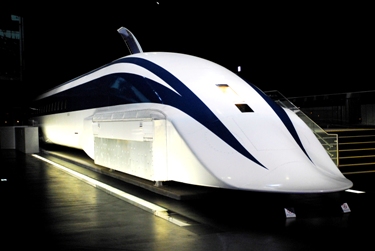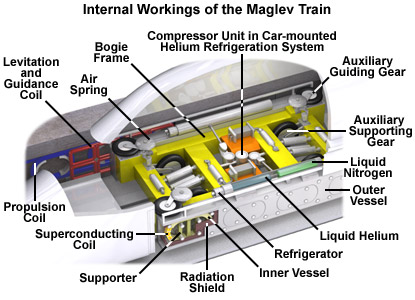What is Japan's JR Maglev-
JR-Maglev is a magnetic levitation train system developed by the Central Japan Railway Company and Railway Technical Research Institute (association of Japan Railways Group). JR-Maglev MLX01 (X means experimental) is one of the newest designs of a sequence of Maglev trains in development in Japan since 1970s. It is composed of a most five cars to run on the Yamanashi Maglev Test Line. On 2nd December 2003, a three-car train reached a maximum speed of 581 km/h or 361 mph (world speed record for railed vehicles) in a manned vehicle run.
Technology behind the speed-
Magnetic levitation trains utilize a levitation system, a driving system and a guide system.
The JR-Maglev levitation train make uses an Electro-dynamic Suspension (EDS) system. Moving magnetic fields generate a reactive force in a conductor as a result of the magnetic field induction effect. The force holds up this train. The maglev-trains have superconducting magnetic coils, and the guide ways hold levitation coils.

When the trains run at the high speed, levitation coils on the guide way produce reactive forces in reply to the approach of superconducting magnetic coils onboard the train.
EDS has the advantage of larger gaps than EMS, but EDS needs support wheels which are employed in low speed running, because EDS can't produce a large levitation force at lower speeds (150 km/h or less in JR-Maglev). Though, once the train reaches a certain speed, wheels will actually retract so that the train is floating.
JR-Maglev is driven by the Linear Synchronous Motor (LSM) System. This system is required to supply power to the coils at the guide way.
Electro dynamic Suspension (EDS)-
Japanese engineers are developing a competing version of maglev trains that make use of an electro dynamic suspension (EDS) system that is based on the repelling force of magnets. The key difference between Japanese and German maglev trains is that Japanese trains make use super-cooled, superconducting electromagnets. This type of electromagnet can conduct electricity even after the power provides has been shut off. In EMS system, that uses standard electromagnets, coils only conduct electricity when a power supply is present. By chilling the coils at frigid temperatures, Japan's system saves energy. Though, the cryogenic system uses to cool coils can be expensive.
Another difference between systems is that the Japanese trains levitate nearly 4 inches (10 cm) above the guide way. One potential disadvantage in using EDS system is that maglev trains should roll on rubber tires until they reach a liftoff speed of about 62 mph (100 kph). Japanese engineers say the wheels are a benefit if a power failure caused a shutdown of the system. Germany's Trans rapid train is equipped with an emergency battery power supply. Also, passengers with pacemakers would must be shielded from the magnetic fields generated by superconducting electromagnets.
The Inductrack as a new technology-
The Inductrack is a new type of EDS that uses permanent room-temperature magnets to generate the magnetic fields in place of powered electromagnets or cooled superconducting magnets. Inductrack uses power source to accelerate a train only until begins to levitate. If the power fails, train can slow down steadily and stop on its auxiliary wheels.

The track is really an array of electrically-shorted circuits contain insulated wire. In another design, the circuits are aligned like rungs in ladder. As the train moves, the magnetic field the repels the magnets, causing the train to levitate.
There are two Inductrack designs as Inductrack I and Inductrack II. Inductrack I is designed for high speeds, even as Inductrack II is suited for slow speeds. Inductrack trains might levitate higher with greater stability. So long as it's moving a few miles per hour, an Inductrack train would levitate nearly an inch above the track. A greater gap above the track means that train would not need complex sensing systems to uphold stability.
Permanent magnets had not been used before since scientists thought that they will not create enough levitating force. The Inductrack design bypasses the problem by arranging the magnets in the Halbach array. The magnets are configured so that intensity of the magnetic field concentrates above the array rather than below it. They are made from a new material comprising a neodymium-iron-boron alloy, which generates a higher magnetic field. The Inductrack II design incorporates two Halbach arrays to produce a stronger magnetic field at lower speeds.